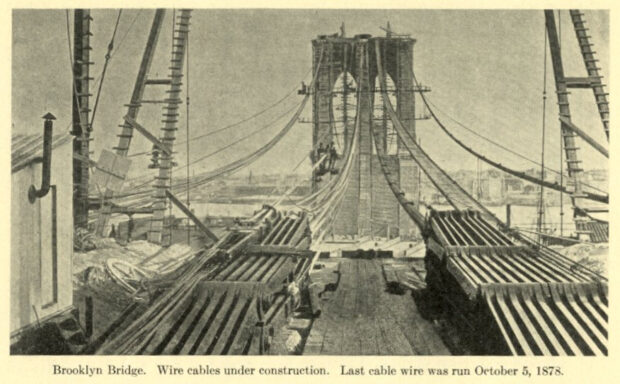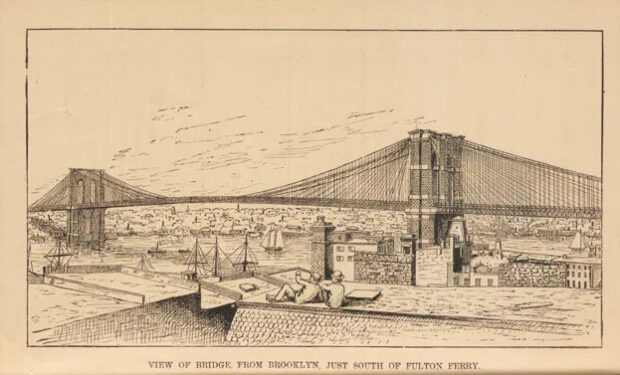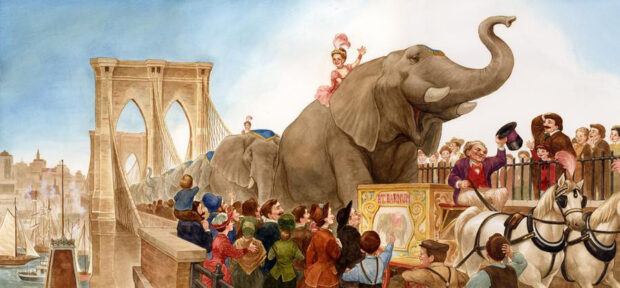There are a total of 65 bridges in New York, which connect the individual areas of this large city that are divided by the water. One of these many bridges, the Brooklyn Bridge, is probably one of the most famous bridges in the world.
It connects the two districts of Manhattan and Brooklyn and was completed in 1883, making it the oldest bridge over the East River. Ferries were previously used to reach these parts of the city, and when the Brooklyn Bridge opened it was a sensation. It was the longest suspension bridge in the world and was able to hold this record for 20 years.
READ 15 Best Places in Winter New York
The construction of the Brooklyn Bridge from 1870 to 1883 is an interesting but also very tragic story.
The civil engineer John Roebling was responsible for the planning and supervision of this huge construction project. The idea to build this gigantic bridge came to him when he got stuck on a ferry from Manhattan to Brooklyn in the frozen East River.
John Roebling (his original name was Johannes August Röbling because he was German) succeeded in convincing the New York City Council to build a bridge over the East River in 1857.
But it would take years before the building permit was granted and the necessary funds were made available. When construction began in 1869, when his dream of a bridge over the East River was finally about to come true, John Roebling had a surveying accident so badly that his foot soon had to be amputated. As a result, he suffered blood poisoning and died shortly afterward.
Washington Roebling, his 32-year-old son, who had already worked with his father on other bridge constructions, subsequently took over the construction management.
READ New York City’s Roosevelt Island: 9 things to do
The foundations for the two pillars of the bridge were created using the method of founding a caisson, which was new at the time.
This caisson, open at the bottom and made of wood, was weighted from above and thus lowered into the water. The water was then displaced from this hollow box by means of overpressure so that it could be entered by the workers. Centimeter by centimeter was then excavated, which gradually sank the caisson deeper and deeper.

The working conditions in such a caisson were inhuman and also extremely dangerous, as scientists only realized later. Many people who had to work down there had symptoms such as shortness of breath, loss of consciousness, paralysis, ruptured eardrums or even bleeding from the nose and mouth.
When Washington Roebling also climbed into the caisson to personally monitor the progress of the construction work, his health suffered serious damage. From that day on he had to spend the rest of his life in a wheelchair because he was partially paralyzed. His eyesight also deteriorated more and more.
READ Brooklyn: an Area With a Rich Past
It was not until much later that the scientists recognized the reason that was responsible for these effects: insufficient pressure equalization when leaving the overpressure area in the caisson. This disease is now called caisson disease or diving disease.

Another 20 workers lost their lives in the construction of the bridge. But Washington Roebling did not give up, he wanted to make his father’s dream come true. He took a hotel room from which he could watch the construction work with a telescope, and appointed his wife Emily to be assistant engineer. And for the next eleven years until the construction work on the Brooklyn Bridge was completed, she reliably conveyed her husband’s instructions to the engineers.
The inauguration of the Brooklyn Bridge took place on May 24, 1883. The bridge was opened to traffic by the American President Chester A. Arthur. Emily Roebling was the first to cross the bridge with a group of guests of honor.

In other words, she wasn’t actually the first person to walk across the bridge. Because nobody really believed in the resilience of the new bridge, the Barnum circus was first sent over the bridge with a number of elephants. After this “mammoth test”, the bridge was an absolute sensation and was sometimes even admired as the 8th wonder of the world. From a technical as well as an architectural point of view, it set completely new standards.
The Brooklyn Bridge has a span of 486 m between the two central masts and the length of the track from anchorage to anchorage is 1,091 m.
The latest techniques were used, from the manufacture of the suspension ropes to the sinking of the load-bearing parts in the river bed. Granite was used for the two towers of the bridge, which protrude around 82 m from the river. Each cable on which the bridge hangs consists of 5296 kilometers of galvanized wire (galvanizing means: an object is electrically coated with a thin layer of metal to protect it from rust or destruction).
Originally, both lanes, rails and a pedestrian promenade led across the Brooklyn Bridge. It speaks for the skill of its designers that it can cope with the 100,000 vehicles that run on it every day without showing any signs of damage, a burden that no one would have expected during its planning and during the construction period.
Washington Roebling remained paralyzed forever, but recovered so far from his illness that he was 89 years old and could look forward to the completion of this construction project for a long time.
Like us on Facebook for more stories like this: